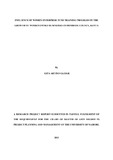| dc.description.abstract | The Women Enterprise Fund (WEF), a Kenya Government Initiative aims to develop and
grow women-owned Micro, Small and Medium Enterprises (MSMEs). Eight years since
its inception, it is imperative to establish whether the training provided by the WEF is
achieving its objectives in influencing the growth of the women owned retail enterprises.
This study was be guided by three objectives: i) To assess how group cohesion as
entrepreneurship training program influences growth of women owned business. ii) To
assess how management practice as entrepreneurship training program influences growth
of women owned business. iii) To assess how credit policing practice as entrepreneurship
training program influences growth of women owned business. The findings of this
research report can give valuable information to stakeholders involved in promotion of
women owned enterprises, challenges faced will be understood, information collected will
act as literature review for future academicians as well as the achievement of some of the
key pillars of the vision 2030. The study utilized a descriptive survey design. The target
population for the study was the women trained during the year 2010/2011, 2011/2012 and
2012/2013 financial years by the Coast region WEF office. The study sample comprised
of 282 women in Mombasa County from 35 different trained groups. The study used
questionnaire and focus group discussion with the members for data collection. The
instruments validation exercise was done by the supervisor and a pilot study. Cronbach’s
Alpha was used to test reliability of the questionnaires used in the study. Raw data
collected was organized into themes, grouped, interpreted and presented in frequency
tables and cross tabulation. Data analysis was done for descriptive analysis using
frequency percentages. The findings were summarized, discussed and conclusion made.
The study established that the WEF training program was efficient in improving group
cohesion but does not influence the group in increasing the number of activities the groups
are involved in. The study also reports that after training there was a positive influence on
record keeping as an average 30% increase in the respondents keeping different business
records after the WEF training was recorded. This indicates improved management
practices but the training had little influence on helping them with business planning
documents. The study also established that even after the training around 50% of the
respondents continue with the same trend in the credit limit, credit period and the restock
level which indicates poor credit policing practices which the training was not able to
influence. The researcher has given recommendations based on the conclusions that the
women should be trained on how to make a meeting agenda, minutes and follow up of the
minutes in the next meeting as this will allow them to have continuity and also make
proper use of the meeting time. The researcher recommends entrepreneurial skills
equipping programs to be incorporated more into the current curriculum as the training is
more inclined on the WEF products. The researcher also recommends more customised
training sessions as different groups have different business ventures. From the focus
group discussions carried out by the researcher, it was found that the trainer of the WEF
training program influenced the women into applying for the program, hence for further
research the researcher suggest a study on the role of the trainer of the WEF training
program on the influence of the growth of women owned business can be carried out. | en_US |

